Reflections on Indian Wells 70.3: Polarized Training and LCHF Diet
- Posted on
- By Antonio Gonzalez
- Posted in training/coaching
- 8

3 month training review for a half ironman triathlon while following a Polarized training model and low carb, high fat diet.
Instead of a standard race report, I thought a more interesting and insightful (albeit much longer!) read would be a review of my 3-month training cycle leading up to Indian Wells 70.3. I had a few goals and things I wanted to test out heading into this event:
>Continue experimenting with a “Polarized Training Model” in my training
>Experiment with a lower carb, higher fat diet (LCHF)
>If all went well hopefully qualify for the 70.3 World Championships in New Zealand.
When the race was said and done, I finished with a 70.3 PR of 4hr 20min, 2nd place age group finish and slot to the World Champs, and most importantly a deeper understanding of Polarized Training and LCHF nutrition and it's application to racing the 70.3 distance. Below I’ll dive into the details of what I did in training, what I learned, and what I would change in the future.
I had a 3-month training block to prepare for Indian Wells, which started in early September. A fair base level of fitness was established earlier in the season with a decent performance at 70.3 St. George, with a finishing time of 4hr39min. I backed that up a couple months later with an enjoyable experience and finishing time of 9hr 55min at my first full distance triathlon event at Challenge Roth in Germany.
Indian Wells is positioned conveniently at the end of the season (December 7th), which for me is our slow time at the bike shop. This allowed me to increase my average training time from 9hrs per week (Jan-Aug) to 11hrs per week (Sept-Nov). Those two extra hours per week may not sound like much, but I’ve learned that I respond well to volume and any time I can sneak in more training time I should take advantage of it.
*Key thought: if you train <10hrs per week I highly recommend taking advantage of any opportunity to sneak in more aerobic training time.
I broke this 3-month training block into a nine week ‘base’ cycle and a four week ‘build’ cycle.
My training focus during the nine week base cycle was simple:
>Maintain consistency by following a standard weekly routine and exercise nearly every day.
>80% of my workouts will be “low intensity”.
>20% of my workouts will be “high intensity”.
You can see in the chart below the consistent weekly volume, gently pushing it up over nine weeks. Very simple and classic stuff. My key sessions during this period of time were the long swim, bike, or run workouts, in which I wanted to finish them feeling “pleasantly tired”, and never “completely spent”.
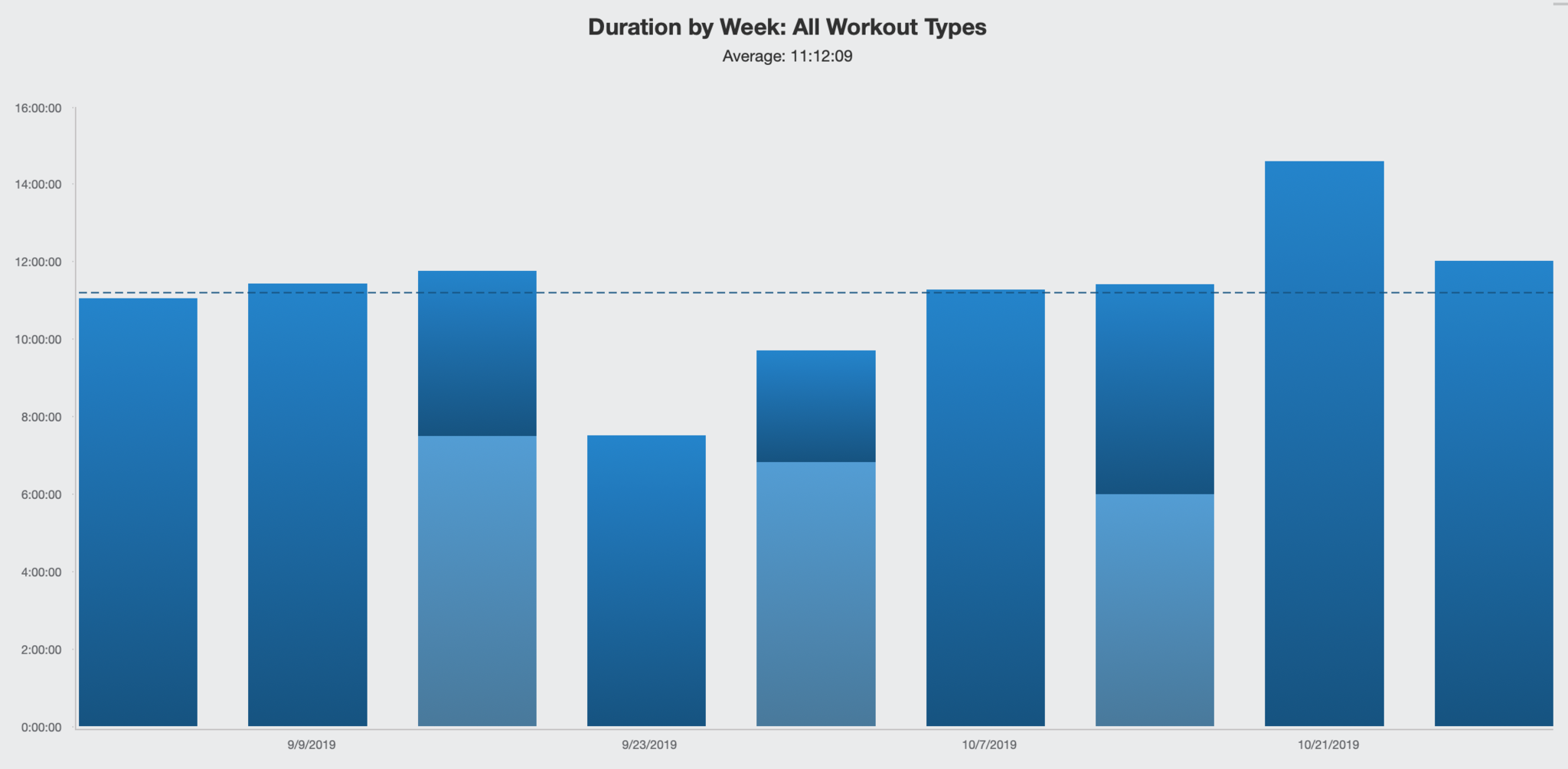
I used a simple 3 zone training intensity model to guide my training. These zones were determined by blood lactate threshold testing conducted at our shop:
>Zone 1: ‘low intensity’ includes all base building and recovery workouts (for me HR typically below 130 on the bike, and 140 on the run)
>Zone 2: ‘mid intensity’ includes tempo and sub-threshold (for me HR below 150 on the bike and 160 on the run)
>Zone 3: ‘high intensity’ include above-threshold racing and intervals.
The chart below shows the results of my blood lactate threshold test conducted on the bike in August, soon before starting the base training block. We look for key lactate levels as well as jumps in blood lactate to determine the 3 training zones:
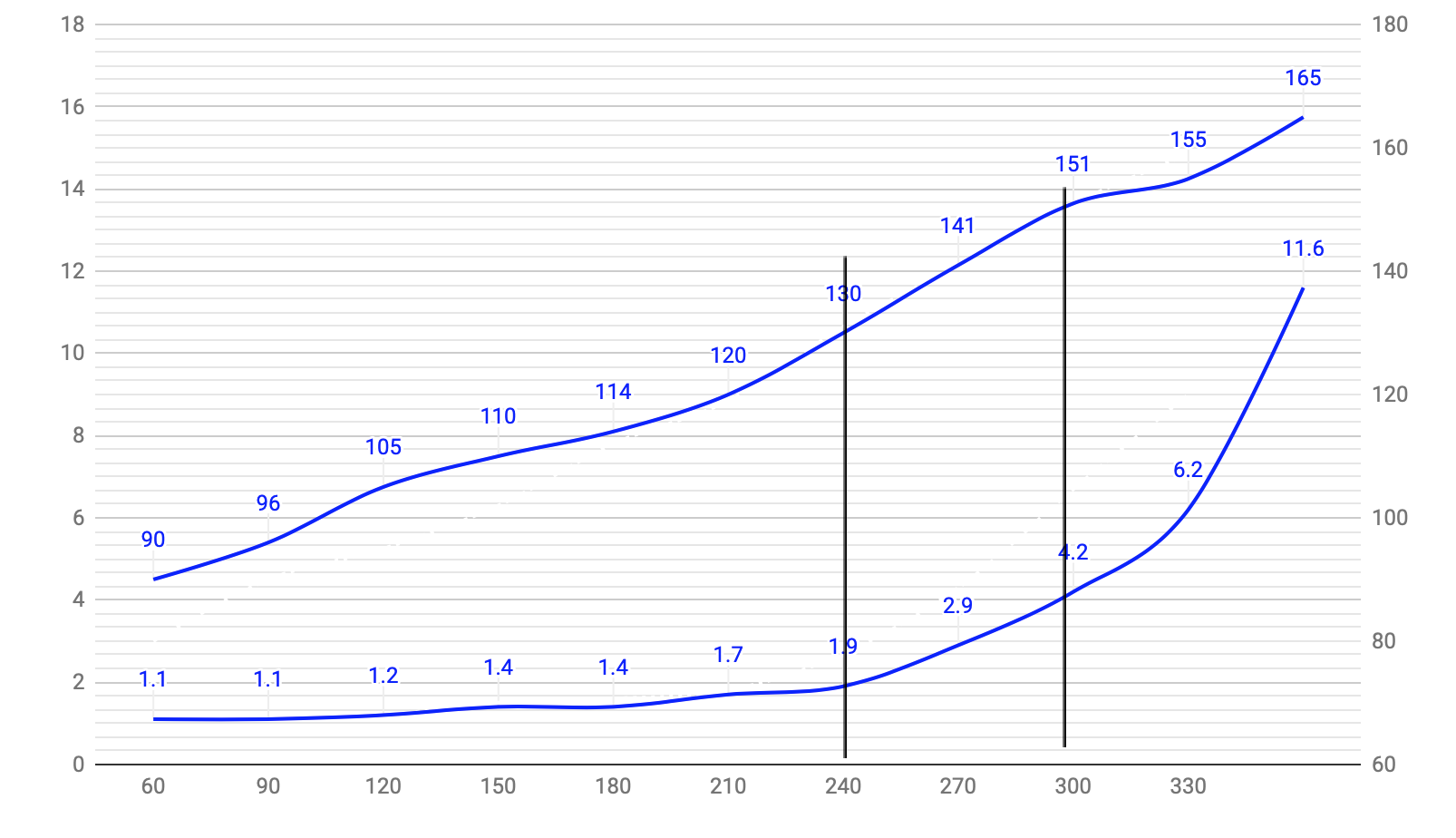
The chart below shows my time spent in these zones during the nine week base training cycle. I believe the disciple in keeping most of the effort in the ‘low intensity’ aerobic window allowed me to avoid illness and injury during this time. I ultimately only missed four days of training during these nine weeks, and two of those days were due to travel. Most importantly, this was done without feeling burned out or overly fatigued while maintaining work and family responsibilities.
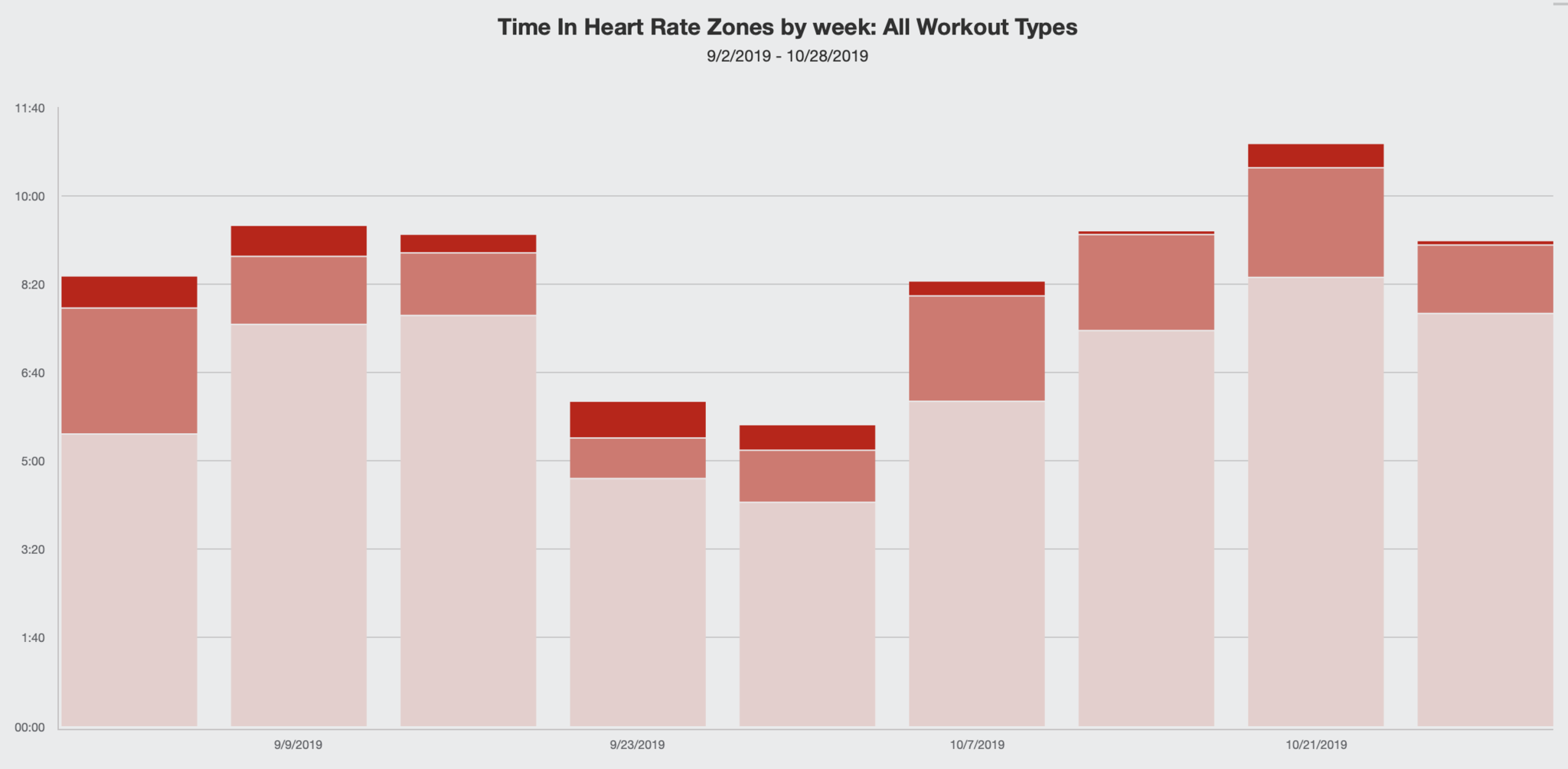
And a different perspective of the same data:

True advocates of the Polarized Training Model will say that I should spend less time in Zone2, and more in Zone3. But when looking at heart rate data you must consider that your heart rate will drift through Zone2 on its way to Zone3, effectively skewing the data in favor of time spent in Zone2.
The final key component of this base building cycle was adjusting the macronutrient component of my diet. I typically have a relatively poor, carbohydrate (CHO) dependent diet. I took an online course and read as much as I could on the LCHF diet, and decided to give it a shot. My nutrition focus during this time was also simple:
>Record all my nutrition on MyFitnessPal
>Record my morning blood glucose levels
>Try to keep my CHO intake below 150g per day during the base building period.
As you can see from my body weight and waistline chart below (entire 2019 season), these three things resulted in some rather sudden and dramatic changes in my body composition. I lost 8lbs in a month and 2 inches off my waistline. During this time, my macronutrient breakdown was approximately 20% CHO, 50% fat, and 30% PRO. Also of interest, during the first 2/3 of the season I lost only 4lbs of weight and .5'' off my waist despite completing a 70.3 and full distance ironman. This further confirms in my mind that body composition has more to do with dietary choices than exercise.
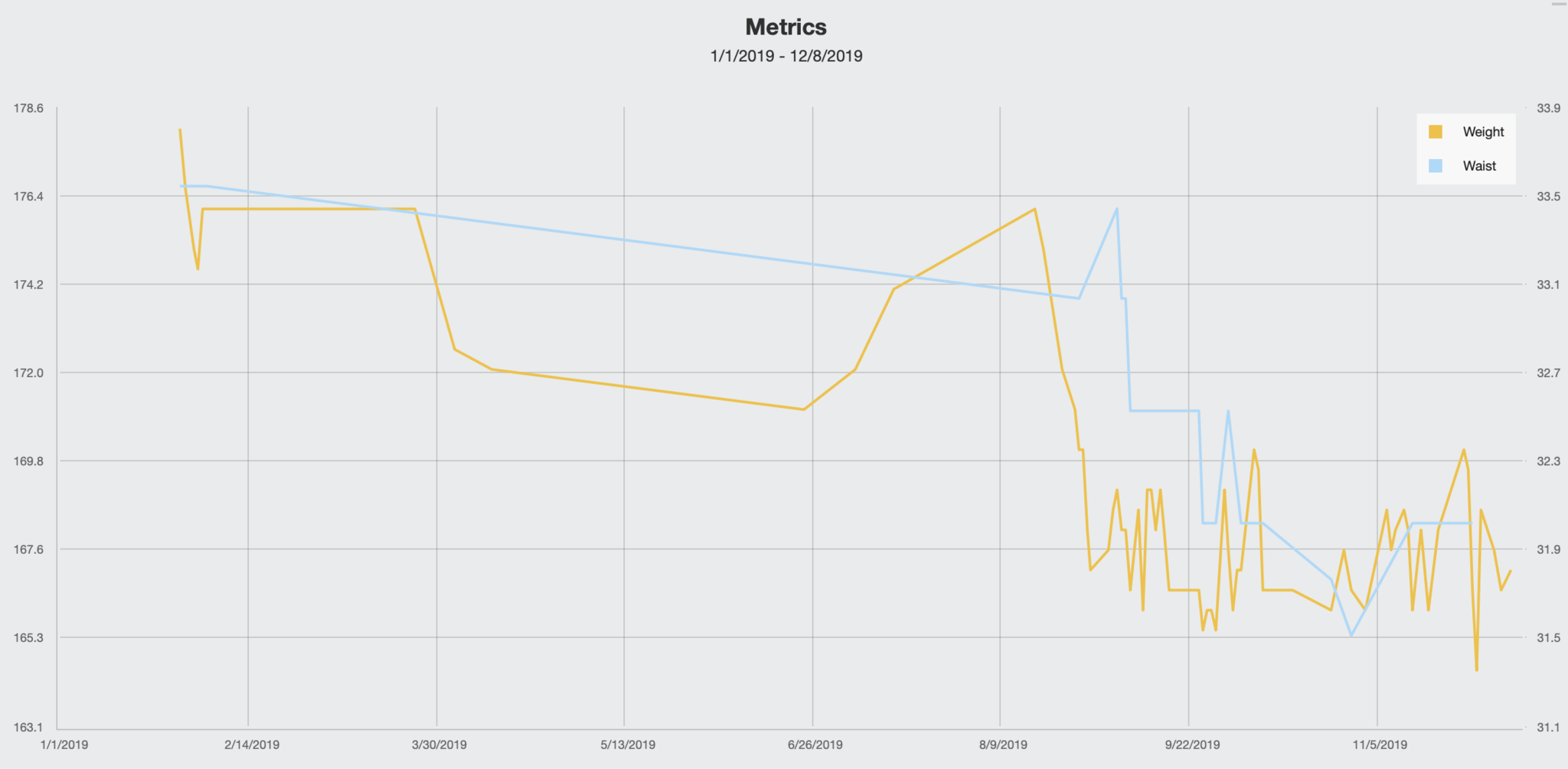
As interesting as this is, I do not believe the LCHF diet is the most important component of this change. Instead, the daily measuring and reflection on food choices naturally promotes better decision making. Like most people- I feel like I know what healthy eating is, I often just chose to ignore the wise decision in favor of the easy one.
Key thought: That which gets measured, gets managed.
These dietary adjustments were combined with completing a much higher percentage of workouts in a near-fasted state. The application of that meant I would wake up, have some coffee with cream, then complete the workout. Any low-intensity workout below 60min would be completed fasted, and most long weekend rides would be completed with only water and electrolytes for the first 2-3hrs. I found the shorter workouts easy and actually more pleasant to do fasted, but some of the longer rides became emotional after a couple hours. By the end of the base cycle I was able to complete an 80 mile Zone1 ride on just water, electrolytes, and about 50g of CHO (an average rider may take in 50g per hour of CHO) without bonking.
By this time I was feeling fit, but by no means race ready. It was time to do some more race-specific work.
The goal of the 4 week ‘build’ cycle was to prepare myself for the intensity and duration of a 70.3 race. This is also where my training began to differ slightly from the classic Polarized training model. I began spending more time in Zone2, albeit at the upper portion of it, which I refer to as ‘Sweet Spot’. The chart below shows how my percentage of training time within the three zones changed during this final block:

The increased percentage of time in Zone3 is due to the fact that while flirting with the upper end of Zone2, you will unavoidably spend some time in Zone3. Remember these zones are simple guidelines and ranges, and not something set in stone.
I combined this increase in training intensity with a gradual decrease in training volume as shown:

My general week structure remained the same during this period of time, but my mid-week Zone3 bike or run workouts became mid-week Zone2 ‘Sweet Spot’ workouts.
Sweet Spot will be just above 70.3 race pace for most athletes, and is an ideal workout to test nutrition, equipment, and pacing. I mapped out a bike and run loop, both 30min in duration, that mimic the profile of the Indian Wells race course. For the bike that means flat and without stops, and for the run it meant a hilly golf course loop. I would complete multiple laps of these circuits at Sweet Spot intensity, gradually building up my tolerance for the workload. Below is an example of one of my key Sweet Spot bike workouts completed a few weeks before race day:
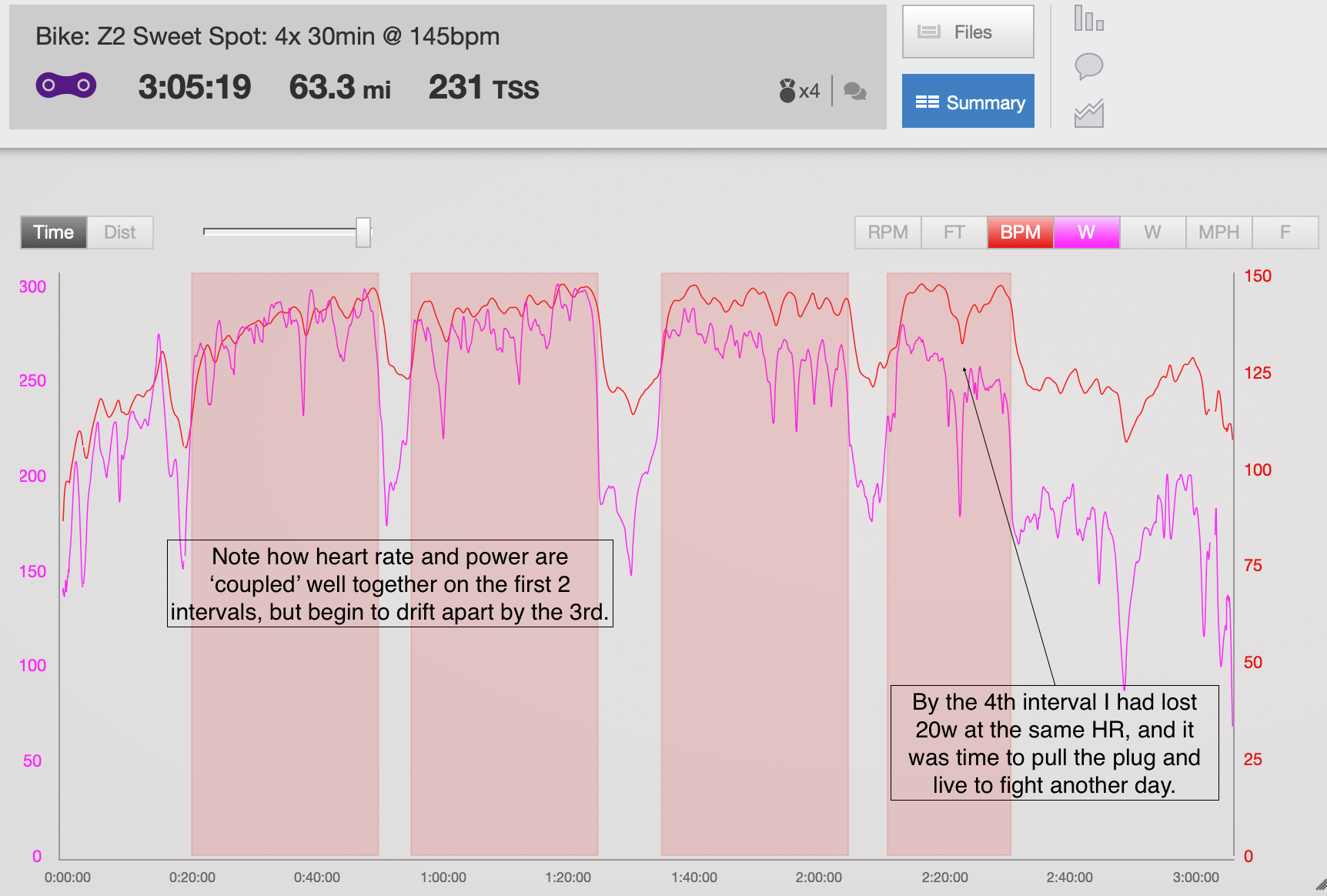
Key Thought: Use Sweet Spot intervals to refine race nutrition, pacing, and equipment.
The only other high intensity workouts I did during this time were a series of Maximum Aerobic Power (MAP) tests. A MAP test is a simple way to measure changes in cycling performance and estimate your VO2 max. I would complete an easy warmup, then starting at 100w increase the power 20w every 1 minute until failure. The results of the three tests are below. The final test I took the Tuesday before race day, and the good result combined with a season high heart rate showed I was fresh and ready to race.
| MAP TEST | 10/22/19 | 11/19/19 | 12/4/19 |
| High Power | 400 | 420 | 440 |
| Body Weight | 167 | 167 | 167 |
| Max HR | 171 | 170 | 178 |
| VO2 Max Estimate | 66.2 | 70.2 | 72.2 |
| FTP Estimate | 302 | 323 | 332 |
My race plan was simple and somewhat flexible:
>Swim at an intensity that feels like 80-85% of my best for the distance.
>On the bike, try to hold power in the middle of Zone2 (240-300w) depending upon how I feel. Do not let power go above 300w for extended periods of time. Take in 60g of CHO per hour, and hydrate based on feel- but at least 24oz/hr with 500mg of sodium.
>On the run try hold an even split, and as fatigue sets in focus on cadence and knee lift. Consume a caffeinated gel at mile 4 and mile 8, and take in water/coke based on feel at the aids stations.
The swim was cold, somewhat rough, and I exited the water in ~32min feeling like I swam well within my abilities without risking the later stages of my race. Time was about the same as St. George.
Onto the bike I was able to average 266w, a solid 10% improvement over St. George while racing 6lbs lighter in body weight. Combined with a flat course this put my time around 2hr 16min for the bike leg. I felt comfortable and in control the entire time while executing my nutrition/hydration plan without issue. I attribute the improvement on the bike to the disciplined aerobic development work and Sweet Spot interval workouts. An interesting note: near mile 45 of the bike I caught a group of age group men and pro female athletes. While riding with this group the last 10 miles of the race my power dropped 20w on average- a welcome reprieve before starting the run. I noticed after the race that my average speed also dropped almost 1 mph though. I would not have been able to drop this group if I had held my same power of 260-280w. But if better trained, a well timed 2-3min surge of 300-320w may have been enough to make a separation before falling back into my race-sustainable pace. This is something to work towards, and more a concern for elite racers, and a main challenge pro athletes must face in their event.

Onto the run: I was quite happy to see that my highest HR of the day came at the end of the run- something I have not always been able to do in long course races. This shows I did not go out ridiculously fast, I fueled/hydrated relatively well, and that I had the stamina to push it to the very end. If you don’t have your highest HR at the end of your event, it may be a sign that something is off.
My run time of 1hr 27min was about 10min faster than St. George- though I suspect 5min of that is due to differences in the run course. The run file below shows how my pace fell off about 20sec per mile on lap two at Indian Wells. A sign that a faster run is possible, and something to improve upon in 2020. Some may say that I went out too fast, but I would disagree, a negative split run is not necessary in my opinion for long course racing, and may not be desirable as temperatures heat up later in the day. Nonetheless, it is always nice to limit the decrease in pace as much as possible.
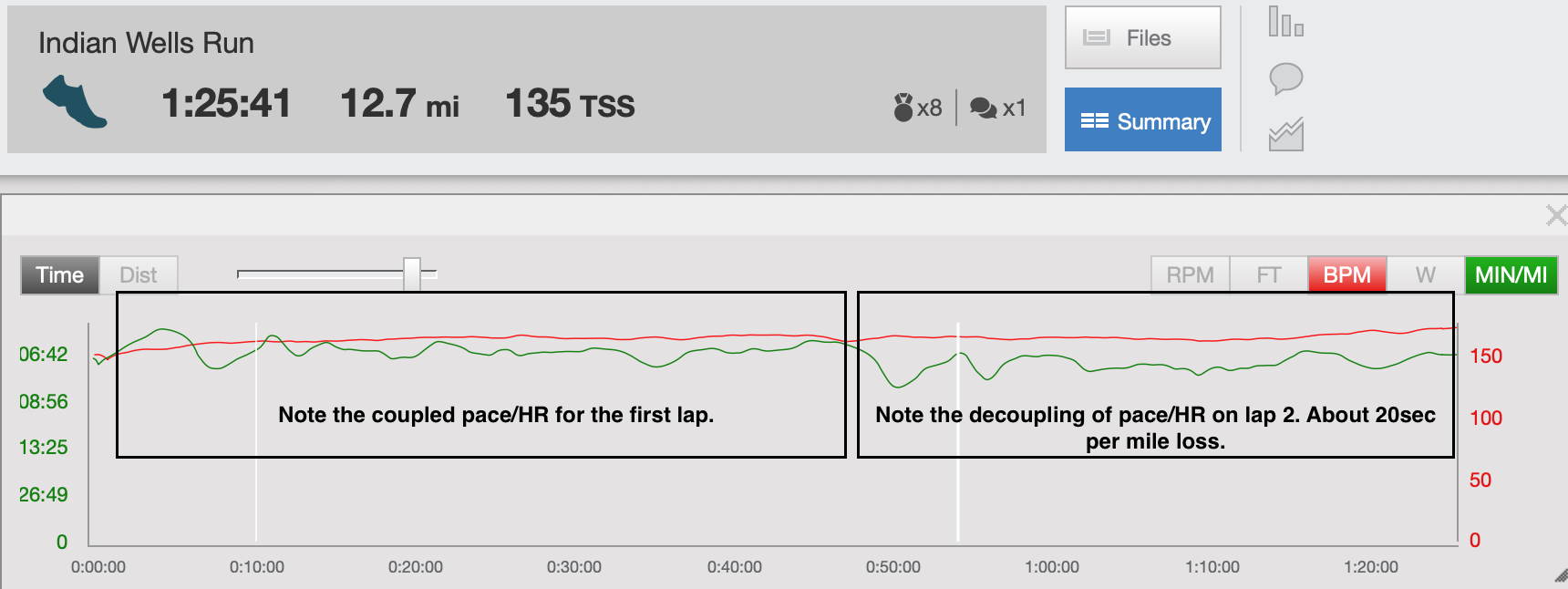
And that's about it- another fun race in the bag. This was especially enjoyable because I feel I learned a fair number of good lessons along the way. To sum up the key lessons from this 3-month training block:
> Prove your consistency before increasing your volume.
> Focus on getting in your volume before increasing intensity.
> Spend the majority of your time at an aerobic intensity even if you have limited time to train.
> Use key workouts to refine race nutrition, pacing, and equipment.
> Adjust your diet to reflect the needs of your training.
Ultimately all points that we've heard before, and in a way it's nice to see improvement while following relatively basic principles. I hope you enjoyed these reflections and insights to my training. Some reflection, planning, and discipline is all it takes to build yourself to a point where your definition of success is no longer just a possibility, but practically guaranteed.
About the Author:
Antonio Gonzalez is the owner of Tri Town Bicycles in Boise, Idaho. He is a endurance coach, bicycle fitter, and veteran of the cycling and triathlon industry for over 20 years.
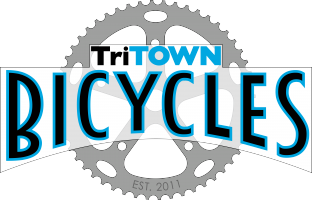
Hey Erin,
Yes would love to hear your insight on a lot of this!
Re LCHF and the concern of decreasing the ability to absorb CHO- I read a few studies touching on this, most recently by Asker Jeukendrup. It was a concern of mine with the LCHF diet. I addressed this during the key ‘sweet spot’ workouts, in which I would take in about 50-60g of CHO per hour, and found the extra calories went down easily enough. Ultimately any sweet spot workout was an opportunity to test race strategy. On race day it felt pretty natural and easy to take in 50-60g per hour.
Re how long I stayed on the LCHF diet: I only really did it for the 9 week base window- in which I averaged about 100-150g per day, mostly dependent upon how much exercise I did. I was never interested in trying to get into ketosis (<50g CHO per day). During the ‘build phase’ I was more around the 200-250g/day- which was still a lot less than I would have done under my more ‘traditional American’ diet. I believe my macronutrient breakdown hovered around 40% Fat, 30% CHO, 30% PRO during this build phase (vs 50% Fat, 20% CHO, 30% PRO during the base phase).
I definitely didn’t feel glycogen depleted going into the race- probably due to tapering and keeping my caloric intake higher than necessary for the exercise (or lack thereof) I was doing race week. Interestingly my weight did not increase during the build or taper phase, despite the higher CHO content.
The weather was mild- overcast for the first part of the day, and a high of about 70 degrees.
Will have to catch up in person later!
AG
Hey Dan,
Glad you found the article interesting. Some feedback:
> Re the weight loss and LCHF diet: I suspect the main reason for the weight loss was the combination of fasted workouts, counting my calories (just eating less), and the decreased CHO in my system means I would be carrying around less water weight.
> Re fasted workouts: I was not doing them prior to the LCHF diet.
> Re LCHF vs Plant-Based vs No Sugar No Processed Foods: I agree that just eating a diet relatively devoid of simple CHO and sugar is probably the low hanging fruit to better health for most people. There is no doubt that I ate “healthier” during the LCHF phase, which is probably responsible for some percentage of the performance improvement. I would suspect that a plant-based diet with adequate PRO intake would have similar or maybe even better results to LCHF.
> Re Polarized training and coming off Challenge Roth: I took 2 months mostly easy/off after Roth, and felt that a period of time re-establishing base and getting into the routine of working out 6-7 days per week would be helpful. I did not do the 9 week base-period to promote recovery from Roth…. I felt fully recovered from Roth before starting this block.
> Re polarized training: I would recommend this 80-20 if not even 90-10 mix during the base period, thought am not convinced it’s best during the final 6-8week build for the 70.3 athlete. This is why I spent more time at ‘sweet spot’ during the build period, which is around the upper part of Zone 2 (but still harder than 70.3 race pace).
Thanks for the feedback Dan!
Good stuff Antonio! One thing about your self-experimentation is that you approach it pragmatically and more scientifically than most would.
I noticed that your race day CHO consumption was similar to general guidelines at 60g/hr. Since you’d done so many workouts fasted or in a carb-depleted state, did you have any trouble consuming this amount of carb during the race? One of the caveats of going LCHF is that you can down-regulate your CHO absorption to the point where your body will reject a “normal” fueling plan on race day. Obviously it didn’t hurt your performance but I’m curious if you noticed anything in this area.
Also- did you follow LCHF all the way to race day? Or did you go through a carb-repletion phase just before the race? Glycogen holds a lot of fluid in the body so I’m always concerned if athletes go too low leading into the race, which can lead to dehydration. Was weather pretty moderate?
So many more questions about how you structured your week and how swimming fit into this training model. Let’s talk more. :-)
Congrats on a stellar race and getting that slot in NZ!
Thanks for posting... I love data and this is really intriguing. I have re-read this multiple times. Thanks for sharing and keeping close tabs on your numbers so that measurements/results are more accurate.
A few questions/thoughts...
Could the result of your weight loss not have anything to do with your LCHF diet but, rather, be a result of your morning training in a near-fasting state? I am curious if that was the variable that made the difference. Where you doing training in a fasting state prior to implementing the LCHF diet?
Keto and LCHF seems really trendy right now both in athletics and in our general society. Most everyone has seen “The Magic Pill” on Netflix and it carries some compelling arguments for a LCHF diet. But also watch “The Game Changers” which offers equally compelling arguments for a plant-based diet. Having been a runner before triathlon, I have admired Rich Roll, a vegan ultra-runner. I am leaning more toward zero meat and a plant-based diet over LCHF. This is a great statement… “That which gets measured, gets managed". What if it is not a LCHF diet or a plant-based diet or a high carbs low fat diet but rather, NO Sugar and NO processed foods! I would be really curious to see what would happen if you went plant-based, still maintained your near-fasting workouts and also continued to avoid junk sugars and processed foods. Great food for thought!
The polarized training data is amazing. It puts the statement “No pain, no gain” to shame. Running in college 25 years ago I always thought that if it didn’t hurt, it wouldn’t make me faster. If I read this correctly, this was a 3 month training block and you were coming off of Roth (a full distance). You had a huge base of mileage under your belt and you were in rock-star shape before starting this 3 month window of training? Was the low HR training functioning more as a Roth recovery and maintenance or as a base for training your heart to be more efficient by highly controlling time/HR/effort, etc…
Also, very curious… what if you were not coming off of Roth or a full-distance IM? Let’s say you are 9 months or 6 months out from your goal race and didn’t have as large a training base… would you still recommend 75% zone 1, 20% zone 2 and 5% zone 1 in earlier stages of training?
Sorry, that was a long message.
Your comment that more time spent doing a LCHF approach might be beneficial I think is very true. Also a targeted CHO approach within that framework for the key workouts is another addition that could amplify the benefits of both the nutrition and training.
Why do you think your Max HR jumped 8 BPM in less than a month? Extra recovered that last test day?
Great write up, thanks for sharing your thoughts
Hey Darin,
Yes, the LCHF nutrition for endurance athletes is ultimately trying to improve your body's ability to metabolize fat at race intensity, saving those precious glycogen stores for the later part of the race when you could really use them. There is mixed research on how effective LCHF really is for the endurance athlete. Hence why I thought I would experiment with it to come to my own conclusions.
An alternative view point on LCHF nutrition, that I didn’t get into in the article, is that ‘training your gut’ to consume a large amount of CHO per hour improves absorption rate and thus glycogen availability. I think most athletes by nature try this approach- often forcing down a fair amount of nutrition during workouts and races. I have a basic issue with this approach- that being that I simply don’t want to consuming that much sugar (a gel is essentially fancy cake icing) on a regular basis. We may become fit, but are we truly healthy off that foundation?
Regarding the next round of experimentation: I haven’t thought that far ahead honestly! I believe a little more time with LCHF nutrition is in order. I have a 4-month base building block starting in January, and plan to follow basic LCHF principles during that time. I also would like to try to do a better job of “polarizing” my workouts during this time- in particular making sure that when I do my Zone3 workouts that I don’t slack off and find myself in Zone2.
In regards to technique: I hope to spend some time doing aerodynamic field testing on my race equipment- something I did earlier in the year, but did not have time to do this fall on my current race bike. I’ll be sure to write about this method in the spring or early summer.
Finally, the low hanging fruit for my run is cadence: I have a 36’’ inseam, and it’s a real struggle to get my cadence above 83-85spm. I believe more work with a metronome, plyometrics, and some focused downhill running will help with that.
Thanks Darin for the questions and sorry for the long response!
AG
Interesting. Thanks for sharing your method. I appreciate the quote, 'That which gets measured, gets managed".
Curious your opinion on LCHF benefit vs. fasting training benefit? Both are techniques intended to increase your body's fat conversion efficiency?
What would you do differently next time? What do you want to experiment or optimize next time?
Great read. Your times for the half and the full are simply amazing. Good work. I enjoyed your insight on the zone workouts. It reminds me of the 80/20 rule. Coincidentally I watched a Ted Talk this morning with the exact same concept for world class endurance athletes. Thanks for the read.
Great report. Congrats on worlds!!!
Bravo. Great report, thanks for sharing!